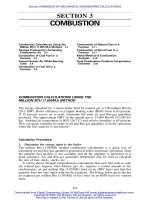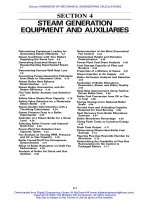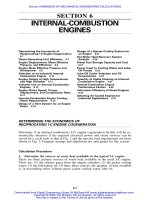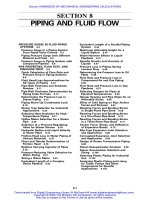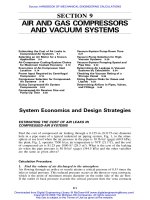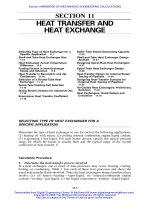Handbook of energy engineering calculations
Bạn đang xem bản rút gọn của tài liệu. Xem và tải ngay bản đầy đủ của tài liệu tại đây (33.29 MB, 1,138 trang )
HANDBOOK OF ENERGY ENGINEERING CALCULATIONS
www.pdfgrip.com
HANDBOOK OF ENERGY ENGINEERING
CALCULATIONS
Tyler G. Hicks, P.E. Editor
International Engineering Associates
Member: American Society of Mechanical Engineers
United States Naval Institute
www.pdfgrip.com
Copyright © 2012 by The McGraw-Hill Companies, Inc. All rights reserved.
Except as permitted under the United States Copyright Act of 1976, no part
of this publication may be reproduced or distributed in any form or by any
means, or stored in a database or retrieval system, without the prior written
permission of the publisher.
ISBN: 978-0-07-174553-6
MHID: 0-07-174553-X
The material in this eBook also appears in the print version of this title:
ISBN: 978-0-07-174552-9, MHID: 0-07-174552-1.
All trademarks are trademarks of their respective owners. Rather than put a
trademark symbol after every occurrence of a trademarked name, we use
names in an editorial fashion only, and to the benefit of the trademark owner,
with no intention of infringement of the trademark. Where such designations
appear in this book, they have been printed with initial caps.
McGraw-Hill eBooks are available at special quantity discounts to use as
premiums and sales promotions, or for use in corporate training programs. To
contact a representative please e-mail us at
Information contained in this work has been obtained by The McGraw-Hill
Companies, Inc. (“McGraw-Hill”) from sources believed to be reliable.
However, neither McGraw-Hill nor its authors guarantee the accuracy or
completeness of any information published herein, and neither McGraw-Hill
nor its authors shall be responsible for any errors, omissions, or damages
arising out of use of this information. This work is published with the
understanding that McGraw-Hill and its authors are supplying information
but are not attempting to render engineering or other professional services. If
such services are required, the assistance of an appropriate professional
should be sought.
www.pdfgrip.com
TERMS OF USE
This is a copyrighted work and The McGraw-Hill Companies, Inc.
(“McGraw-Hill”) and its licensors reserve all rights in and to the work. Use
of this work is subject to these terms. Except as permitted under the
Copyright Act of 1976 and the right to store and retrieve one copy of the
work, you may not decompile, disassemble, reverse engineer, reproduce,
modify, create derivative works based upon, transmit, distribute, disseminate,
sell, publish or sublicense the work or any part of it without McGraw-Hill’s
prior consent. You may use the work for your own noncommercial and
personal use; any other use of the work is strictly prohibited. Your right to
use the work may be terminated if you fail to comply with these terms.
THE WORK IS PROVIDED “AS IS.” McGRAW-HILL AND ITS
LICENSORS MAKE NO GUARANTEES OR WARRANTIES AS TO THE
ACCURACY, ADEQUACY OR COMPLETENESS OF OR RESULTS TO
BE OBTAINED FROM USING THE WORK, INCLUDING ANY
INFORMATION THAT CAN BE ACCESSED THROUGH THE WORK
VIA HYPERLINK OR OTHERWISE, AND EXPRESSLY DISCLAIM
ANY WARRANTY, EXPRESS OR IMPLIED, INCLUDING BUT NOT
LIMITED TO IMPLIED WARRANTIES OF MERCHANTABILITY OR
FITNESS FOR A PARTICULAR PURPOSE. McGraw-Hill and its licensors
do not warrant or guarantee that the functions contained in the work will meet
your requirements or that its operation will be uninterrupted or error free.
Neither McGraw-Hill nor its licensors shall be liable to you or anyone else
for any inaccuracy, error or omission, regardless of cause, in the work or for
any damages resulting therefrom. McGraw-Hill has no responsibility for the
content of any information accessed through the work. Under no
circumstances shall McGraw-Hill and/or its licensors be liable for any
indirect, incidental, special, punitive, consequential or similar damages that
result from the use of or inability to use the work, even if any of them has
been advised of the possibility of such damages. This limitation of liability
shall apply to any claim or cause whatsoever whether such claim or cause
arises in contract, tort or otherwise.
www.pdfgrip.com
To energy-conscious engineers everywhere, and that includes all
engineers: Your energy conservation concerns and efforts were often
laughed at by people who thought our energy supply was limitless.
Today, with energy prices soaring, and concerns over global warming,
the energy-conscious engineer has the respect of almost everyone,
everywhere. May this handbook help your energy design and energy
conservation work to be more widely used, respected, and
appreciated—worldwide.
www.pdfgrip.com
ABOUT THE EDITOR
TYLER G. HICKS, P.E., is a consulting engineer and a successful engineering
book author. He has worked in plant design and operation in a variety of
industries, taught at several engineering schools, and lectured both in the
United States and abroad. Mr. Hicks is the author of more than 20 books in
engineering and related fields, including Standard Handbook of Engineering
Calculations, Handbook of Civil Engineering Calculations, Handbook of
Mechanical Engineering Calculations, and Mechanical Engineering
Formulas Pocket Guide.
www.pdfgrip.com
CONTENTS
Contributors and Advisers
Preface
Acknowledgments
How to Use This Handbook
Section 1. Energy Conversion Engineering
Section 2. Steam Power Generation
Section 3. Gas-Turbine Energy Power Generation
Section 4. Internal-Combustion Engine Energy Analyses
Section 5. Nuclear Energy Engineering
Section 6. Hydroelectric Energy Power Plants
Section 7. Wind-Power Energy Design and Application
Section 8. Solar-Power Energy Application and Usage
Section 9. Geothermal Energy Engineering
Section 10. Ocean Energy Engineering
Section 11. Heat Transfer and Energy Conservation
Section 12. Fluid Transfer Engineering
Section 13. Interior Climate Control Energy Economics
www.pdfgrip.com
Section 14. Energy Conservation and Environmental Pollution
Control
Index
www.pdfgrip.com
CONTRIBUTORS AND ADVISERS
In preparing the various sections of this handbook, the following individuals
either contributed sections, or portions of sections, or advised the editor or
contributors, or both, on the optimum content of specific sections. The
affiliations shown are those prevailing at the time of the preparation of the
contributed material or the recommendations as to section content.
In choosing the procedures and worked-out problems, these specialists
used a number of guidelines, including: (1) What are the most common
applied problems that must be solved in this discipline? (2) What are the most
accurate methods for solving these problems? (3) What other problems might
be met in this discipline? When the answers to these and other related
questions were obtained, the procedures and worked-out problems were
chosen. Thus, the handbook represents a cross section of the thinking of a
large number of experienced practicing engineers, project directors, and
educators.
To those who might claim that the use of step-by-step solution procedures
and worked-out examples makes engineering “too easy,” the editor points out
that for many years engineering educators have recognized the importance
and value of problem solving in the development of engineering judgment
and experience. Problems courses have been popular in numerous
engineering schools for many years and are still given in many schools.
However, with the greater emphasis on engineering science in most
engineering schools, there is less time for the problems courses. The result is
that many of today’s graduates can benefit from a more extensive study of
specific problem-solving procedures.
Edmund B. Besselievre, P.E., Consultant, Forrest & Cotton, Inc.
Robert L. Davidson, Consulting Engineer
Stephen M. Eber, P.E., Ebasco Services, Inc.
Gerald M. Eisenberg, Project Engineering Administrator, American Society
of Mechanical Engineers
V. Ganapathy, Heat Transfer Specialist, ABCO Industries, Inc.
www.pdfgrip.com
Gregory T. Hicks, R.A., Gregory T. Hicks and Associates, Architects
Tyler G. Hicks, P.E., International Engineering Associates
Edgar J. Kates, P.E., Consulting Engineer
Max Kurtz, P.E., Consulting Engineer
Joseph Leto, P.E., Consulting Engineer
Jerome F. Mueller, P.E., Mueller Engineering Corp.
George M. Muschamp, Consulting Engineer, Honeywell, Inc.
Rufus Oldenberger, Professor, Purdue University
John S. Rearick, P.E., Consulting Engineer
Raymond J. Roark, Professor, University of Wisconsin
Lyman F. Scheel, Consulting Engineer
B. G. A. Skrotzki, P.E., Power magazine
S. W. Spielvogel, Piping Engineering Consultant
Kevin D. Wills, M.S.E., P.E., Consulting Engineer, Stanley Consultants,
Inc.
As the handbook user will see, the editor also drew on the published works
of numerous engineers and scientists appearing in many technical magazines
and journals. Each of these individuals is cited in the calculation procedure in
which their work appears. Their position title and affiliation are given as of
the time of original publication of the cited procedure or data.
www.pdfgrip.com
PREFACE
This handbook presents some 2500 calculation procedures in the field of
energy engineering. Each calculation procedure is presented in both the
USCS (United States Customary System) and the SI (System International).
Thus, engineers and designers worldwide will find that each calculation uses
familiar units. Therefore, this handbook is usable by engineers and designers
in every country in the world. Further, many of the calculation procedures are
unique—the engineer and designer will rarely find these procedures in other
books, on the Internet, or in reports or technical papers. The author/editor is
currently, and has been, preparing, using, studying, and collecting, unique
and routine calculation procedures during his long active and varied
engineering career.
Topics covered in this handbook include combustion of fossil fuels (the
conversion of energy from one form to another usable form), steam-power
plants, gas-turbine power generation, internal-combustion engine power
plants, nuclear power generation, hydro power plants, and alternative energy
generation via wind turbines, ocean tidal power, underwater tidal current
power, solar power, geothermal energy power, and several other schemes for
using nature’s forces to generate power. This handbook also includes
calculations of heat transfer and energy conservation, fluids transfer energy
engineering, interior climate control energy economics, and energy
conservation and environmental pollution control.
In preparing this handbook the author has been constantly aware of the
effects on global warming produced by power generators of various kinds,
especially those using fossil fuels. Some experts report that more than half of
atmospheric greenhouse gases emitted today are produced by power
generation using fossil fuels.
Because of the emphasis on global warming throughout the world, each
calculation procedure in this handbook recognizes the impact the particular
form of power generation has on greenhouse gases. Some methods of power
generation directly produce undesirable atmospheric effluents. Other “clean”
or “green” power generation methods are responsible for atmospheric
www.pdfgrip.com
pollution during their manufacturing process. This fact is pointed to by
environmentalists as a negative fact to be held against the “clean” or “green”
method of power generation.
The intense worldwide interest in greenhouse gases, atmospheric pollution,
and global warming started a new vocabulary in the energy engineering field.
Today we encounter terms such as “green” power, “clean” power, carbon
footprint, carbon taxes, energy taxes, biofuel usage, caps on power-plant
carbon dioxide emissions, energy audits, etc. Most these terms imply greater
costs in generating power because of emissions reduction requirements. This
handbook recognizes the new demands on energy-system engineers and
designers and includes calculations that help the resulting design comply with
modern global-warming-reduction requirements.
To reflect modem design conditions, this handbook starts with calculations
of external combustion of fossil fuels used in steam power plants because this
is the widest used (some 70 percent of the total in many areas) form of
electric energy generation today. Next, the handbook presents gasturbine
calculations. Today, gas turbines are the favored motive power choice for
steam-station expansion and topping services. With its small footprint,
freedom from complex regulations, and use of low-emissions natural gas, the
gas turbine is becoming more popular in energy engineering every year. Also,
using heat-recovery steam generators (HRSG) in the exhaust of a gas turbine
allows significant heat recovery while improving the overall cycle efficiency.
Internal-combustion engines—the diesel, natural-gas reciprocating engine,
and other such power generators—comprise the Section 4 of the handbook.
The diesel is a popular form of electric-power generator in rural areas around
the world. And its carbon footprint is not as damaging as that of the
traditional steam plant.
Natural-gas-powered reciprocating engines are popular in oil refineries and
in areas having abundant supplies of natural gas. In some areas these engines
can be run on either natural gas or diesel fuel, depending on which is cheaper.
Cogeneration, wherein waste heat is put to work to improve the overall
cycle efficiency, and to wrest more energy from a given process, is popular
with steam turbines, gas turbines, and internal-combustion engines. Since
greenhouse gases can be reduced when fuel consumption is lowered,
cogeneration is an important step in conserving, and reducing, fossil-fuel
usage. This handbook presents a number of cogeneration calculations that can
www.pdfgrip.com
help engineers and designers reduce fossil-fuel consumption while increasing
cycle efficiency.
Nuclear-power generation calculations are presented in Section 5 of this
handbook. Nations around the world are rapidly adopting and building
nuclear power plants of large capacity. In the United States, after more than
30 years of being ignored—nuclear power is now suddenly back in favor as a
non-atmospheric-polluting source of electric power. Some large power
companies are planning on shutting down older coal-fired plants in
anticipation of new nuclear generating stations. But even though the steam is
generated by a nuclear reactor, the steam- and power-generating cycles are
much the same as in a conventional oil-, gas-, or coal-fired plant. So the
thermodynamic analyses of the steam cycle follow traditional methods. A
number of calculations presented in this handbook bring the engineer and
designer “up to speed” in the nuclear field, which is growing in importance
every day throughout the world.
The nuclear crisis that occurred in Japan in March 2011, though produced
by natural causes, has the world reviewing its nuclear power plants. While
many countries say they will not stop building new nuclear power plants,
these countries add that they are fully reviewing all safety features of such
plants. The likely outcome is that new nuclear power plants will have a
variety of advanced safety features not seen in earlier plants, Some engineers
are considering triple redundancy for cooling systems and other critical
emergency controls.
Nuclear power-plant accidents are feared by almost everyone because of
the radiation danger to people in nearby cities and towns. Since radiation
cannot usually be seen, it is feared more than a danger that’s visible. For this
reason the public is more likely to reject a proposed nearby nuclear power
plant with the famous retort “not on my backyard.” Hence, engineers expect
greater resistance to locating new nuclear power plants near populated areas.
The eventual outcome to such resistance is difficult to predict. But
engineers familiar with the world’s huge energy demand, and the projected
future population growth, make a unanimous prediction: nuclear power plants
are the only viable choice for supplying the electrical energy demanded by
the world’s growing population and expanding industries. Like it or not,
nuclear power is the world’s most likely future large-scale electrical energy
power source.
www.pdfgrip.com
Section 6 of this handbook covers hydroelectric generation of electrical
power. Long a “clean” energy source, hydro power is limited by the number
of suitable sites that can be found for new plants. Today, “small-scale” sites
are popular. Calculation procedures given in this handbook show how such
small-scale sites can be used and the types of turbines most suitable for such
sites. Using the data provided, an engineer can safely choose a site, and its
equipments, to generate “clean” energy.
Wind power is another “clean” energy source and it is covered in Section
7. Calculation procedures in this section cover the range of wind turbines
available today. With wind farms on both land and sea throughout the world,
a steady growth in the generation of power from this source is forecast. The
capacity of wind turbines increases almost every year, providing larger output
from each unit and each farm. With some states ordering electric utilities to
generate 20 percent of their output from renewable energy sources by 2020,
or sooner, the future of wind power is most promising.
Section 8 of this handbook covers solar-power energy applications and
usage. A number of calculation procedures show how to select solar panels
and other devices for efficient use of sun-generated electric power. Many new
ways to use solar panels are being found throughout the world. Thus,
automobile parking fields are being covered with solar panels to generate
electric power for local structures—schools, shopping malls, office buildings,
etc. Another advantage of such panels is that they can generate power to
recharge electric-powered cars when both solar panels and electric-powered
vehicles become more common. So, as with wind power, the future of solar
power is also most promising.
Geothermal energy engineering is covered in Section 9 of this handbook.
As with hydroelectric power, geothermal power is very dependent on
available sites. There are very few suitable geothermal sites worldwide. But
for those that are available, the calculation procedures in this section show
how to make maximum use of the available energy. And the various types of
steam-generating cycles that can be used are fully explored in the procedures
presented. Any engineer can become reasonably conversant with geothermal
energy engineering in a few hours using the calculation procedures in this
section of the handbook.
Ocean-energy and tidal-stream energy calculation procedures are presented
in Section 10. Again, as with hydro and geothermal energy engineering,
www.pdfgrip.com
ocean energy and tidal power depend on suitable sites, and the number of
suitatable sites is relatively few, yet engineers continue to try to develop
machinery that can be used in normal ocean waters to generate electric
power. Calculation procedures given in this section show how to utilize
suitable ocean sites to generate electric power reliably and economically. The
search for more ways to harness the waves and tidal changes to generate
power will continue for as long as civilization needs electricity.
Heat transfer and energy conservation calculation procedures are presented
in Section 11 of this handbook. Since energy can be used and reused with
proper heat transfer, as well as conserved, the calculation procedures in this
section are very important to energy engineers worldwide. Energy
conservation by reducing heat losses and conserving available heat are
important topics covered in this section of the handbook.
Section 12 deals with the important topic of fluid transfer engineering.
Thus, piping, pumps (of many different types), fluid viscosity, energy
conservation in choice of pump, materials selection for pump parts, and
economic competitive analyses are some of the topics covered in Part 1 of
this section of the handbook. Part 2 of Section 12 focuses on choosing heat
insulation for piping; orifice-meter selection; relative carrying capacity of
piping; water-meter sizing, liquid siphons, water hammer, compressed-air
and gas piping, design of steam transmission piping; desuperheater analysis;
steam accumulator selection and sizing; choosing plastic piping; estimating
costs of steam leaks; and line sizing for flashing steam condensate, plus many
other important energy-related fluid transfer calculations.
Interior climate control—heating, ventilation, and air conditioning—is
covered in Section 13 of the handbook. Since heating and air conditioning are
amongst the largest energy consumers in today’s commercial and residential
buildings, a large number of calculation procedures are presented in this
section. With the emphasis on LEED (Leadership in Energy and
Environmental Design) Green Building Rating System™, there is intense
interest in energy conservation in every type of new building being
constructed today. Likewise, there is great interest in rehabbing existing
buildings so they, too, become LEED rated.
An interesting study of the outcome of the LEED program was recently
published. The study showed that LEED-rated buildings saved on energy
www.pdfgrip.com
costs during their entire life cycle. Further, the energy and cost savings were
such that the owners earned more from each building even though the LEED
program might have been more expensive during the construction of the
building.
With the higher costs of energy today, engineers and designers are
conscious of producing more efficient designs for heating, ventilating, and air
conditioning. Calculation procedures in Section 13 of this handbook cover
many topics, including energy equations of a variety of types, annual heating
and cooling costs, energy savings using ice-storage systems, run-around heat
recovery, heating capacity requirements for buildings with steam- and hotwater heating, carbon dioxide buildup in occupied spaces, centrifugalcompressor power and energy input, fan and pump energy performance, airbubble enclosure energy analysis, expansion-tank sizing for hydronic
systems, heat and energy-loss determination for buildings of all sizes and
dimensions, heating apparatus steam and energy consumption, air-heating
coil selection and energy analysis, energy and heat-load computation for airconditioning systems, plus numerous other interior-climate and energy
control calculations. Using the data given, any engineer or designer should be
able to prepare a preliminary design and analysis quickly and easily for any
structure anywhere in the world.
Section 14, the final one in this comprehensive handbook, covers energy
conservation and environmental pollution control. Both of these topics are of
key importance in today’s competitive energy world. Calculation procedures
covered include atmospheric control system energy investment analysis,
energy-from-waste economic analysis, emissions reduction using flue-gas
heat recovery, cogeneration heat savings, cost of cogeneration heat-recovery
boilers, sizing an electronic precipitator for air-pollution control, explosivevent sizing for industrial buildings, thermal pollution estimates for power
plants, flash steam heat-energy recovery for cogeneration, environmental and
safety-regulation rating for equipment, high-temperature hot-water heating to
save energy, repowering options for power plants, energy aspects of coolingtower choice, plus numerous other key calculation procedures for energy
conservation and environmental pollution control.
Each section is introduced with technical parameters important to the topic
of the section. These parameters also provide last-minute information on
energy facts important to engineers designing, building, and operating
www.pdfgrip.com
energy-using facilities. Having these parameters on hand will help energy
engineers stay familiar with current important developments.
Great care has been used throughout the long preparation of this handbook
of energy engineering calculations to be exactingly accurate. But errors can,
and do, occur. If a user finds an error the editor would appreciate being
informed about it immediately. You can reach him personally on the Internet
at: 24/7. Or you can write him in care of the publisher. In
closing, it is the sincere hope of the editor that you find this handbook helpful
in the daily work of your energy engineering activities.
TYLER G. HICKS, P.E.
www.pdfgrip.com
ACKNOWLEDGMENTS
The contributors and advisers consulted hundreds of sources when preparing
the material for inclusion in this handbook. Besides using the books and other
publications listed as references in the “Related Calculations” for most
procedures, the editor, contributors and advisers consulted and drew material
from technical magazines and journals, trade-association standards,
engineering and scientific papers, industrial and engineering catalogs, and a
variety of similar publications. Most of these are noted in appropriate places
throughout the handbook. Additional acknowledgments, listed in the order
received, are given below.
Data and charts credited to the Hydraulic Institute are reprinted from the
Hydraulic Institute Standards, copyright by the Hydraulic Institute, and from
the Pipe Friction Manual, copyright by the Hydraulic Institute. Data on
diesel engine cooling systems are reprinted from Standard Practices for
Stationary Diesel Engines, copyright by the Diesel Engine Manufacturers
Association. Data on minimum requirements for plumbing are drawn from
the American Standard National Plumbing Code with permission of the
publisher, The American Society of Mechanical Engineers.
Specific firms, trade associations, and publications that were extremely
helpful in supplying data for various sections of the handbook include Martin
Marietta Corporation; Electronic Design magazine; Dresser Industries Inc.—
Dresser Industrial Valve and Instrument Division; Ingersoll-Rand Company;
Anaconda American Brass Company; Waterloo Register Division—
Dynamics Corporation of America; ITT Hammel-Dahl; Mechanical
Engineering, a monthly publication of The American Society of Mechanical
Engineers; McQuay, Inc.; The G. C. Breidert Co.; Modine Manufacturing
Company; Rubber Manufacturers Association; Condenser Service &
Engineering Co., Inc.; Armstrong Machine Works; American Air Filter
Company; Crane Company; Machine Design magazine; The RAND
Corporation; Texas Instruments Incorporated; McGraw-Hill Publications
Company, McGraw-Hill, Inc.; Morse Chain Company; Grinnell Corporation;
General Electric Company; The B. F. Goodrich Company; American
www.pdfgrip.com
Standard Inc.; the American Society of Heating, Refrigerating and AirConditioning Engineers; International Engineering Associates; Taylor
Instrument Process Control Division of Sybron Corporation; Clark-Reliance
Corporation; American Society for Testing and Materials; Acoustical and
Insulating Materials Association; W. S. Dickey Clay Manufacturing Co.;
Flexonics Division, Universal Oil Products Co.; Dunham-Bush, Inc.; Carrier
Air Conditioning Company; National Industrial Leather Association;
Worthington Corporation; Goulds Pumps, Inc. Illustrations and problems
credited to Carrier Air Conditioning Company are copyrighted by Carrier Air
Conditioning Company.
Individuals who were helpful to the editor of this handbook at one or more
times before, and during its preparation, include Lyman F. Scheel, Consulting
Engineer; Jack Jaklitsch, Editor, Mechanical Engineering; Spencer A.
Tucker, Martin & Tucker; Paul V. DeLuca, Porta Systems Corp.; Professor
Steven Edelglass, Cooper Union; Professor William Vopat, Cooper Union;
Professor Theodore Baumeister, Columbia University; Frederick S. Merritt,
Consulting Engineer; James J. O’Connor, Editor, Power magazine; Nathan R.
Grossner, Consulting Engineer; Nicholas P. Chironis, Product Engineering;
Franklin D. Yeaple, Product Engineering and Design Engineering; John D.
Constance, Consulting Engineer; John R. Miller, Texas Instruments
Incorporated; Rupert Le Grand, American Machinist; Ronald G. Kogan,
United Computing Systems, Inc.; Al Brons, Flexonics Div., Universal Oil
Products Company; Carl W. MacPhee, ASHRAE Guide and Data Book;
Frank P. Anderson, Secretary, Hydraulic Institute; Joseph Mittleman,
Electronics; Cheryl A. Shaver, E.E., who was a major help in metricating
several sections of the handbook; Thomas F. Epley, Editorial Director, U.S.
Naval Institute Press; Janet Eyler, Electronics; Charles R. Hafer, P.E.; Calvin
S. Cronan, Chemical Engineering magazine; Nicholas Chopey, Executive
Editor, Chemical Engineering magazine; Joseph C. McCabe, EditorPublisher, Combustion magazine; Francis J. Lavoie, Managing Editor,
Machine Design magazine; Donald E. Fink, Managing Editor—Technical,
Aviation Week & Space Technology magazine; Richard J. Zanetti, Editor-inChief, Chemical Engineering magazine; Robert G. Schwieger, Editorial
Director, Power magazine; Barbara LoSchiavo, Editorial Support, Machine
Design magazine; Michael G. Ivanovich, Editor, Heating/Piping/Air
Conditioning magazine; Calmac Manufacturing Corp. Whose Ice Bank is a
www.pdfgrip.com
registered trademark of that corporation; Joseph Leto, P.E., Consulting
Engineer; Gerald M. Eisenberg, Project Engineering Administrator,
American Society of Mechanical Engineers, who contributed a number of
new procedures and ideas; Stephen M. Eber, P.E., Ebasco Services, Inc., who
also contributed a number of new procedures and ideas; Jerome Mueller,
P.E., Mueller Engineering Corporation, who was most helpful with thoughts
on applied calculation procedures; V. Ganapathy, Heat Transfer Specialist,
ABCO Industries, Inc.; Kevin D. Wills, M.S.E., P.E., Consulting Engineer,
Stanley Consultants, Inc.; Joseph B. Shanley, Mechanical Engineer, who
metricated many illustrations and procedures; and numerous working
engineers and scientists in firms and universities in the United States and
abroad.
I owe an enormous thanks to my long-time Sponsoring Editor, Larry
Hager, of McGraw-Hill Professional. Larry is always available, helpful, and
understanding with his authors. He has put up with this author for 25+ years
and has been a steady hand on the helm for me all these years. I will always
be thankful to Larry for helping me deliver every book on schedule and
within the size requirements of the publisher.
Completion of this handbook would not have been possible without the
enormous help of my wife, Mary Shanley Hicks, a publishing professional,
who worked thousands of hours on the computer and at many other tasks to
put the gigantic manuscript into publishable condition. She—more than the
editor—deserves whatever accolades this handbook earns. And she has the
editor’s grateful thanks for keeping him on the job until the manuscript was
finished.
TYLER G. HICKS, P.E.
www.pdfgrip.com
HOW TO USE THIS HANDBOOK
There are two ways to enter this handbook to obtain the maximum benefit
from the time invested. The first entry is through the index; the second is
through the table of contents of the section covering the discipline, or related
discipline, concerned. Each method is discussed in detail below.
Index. Great care and considerable time were expended on preparation of the
index of this handbook so that it would be of maximum use to every reader.
As a general guide, enter the index using the generic term for the type of
calculation procedure being considered. Thus, for the selection of a
centrifugal pump to reduce energy consumption, enter at pumps. From here,
proceed to the specific type of pump being considered—such as centrifugal.
Once the page number of the specific calculation procedure is determined,
turn to it to find the step-by-step instructions and worked-out example that
can be followed to solve the problem quickly and accurately.
Contents. The contents of each section lists the titles of the calculation
procedures contained in that section. Where extensive use of any section is
contemplated, the editor suggests that the reader might benefit from an
occasional glance at the table of contents of that section. Such a glance will
give the user of this handbook an understanding of the breadth and coverage
of a given section, or a series of sections. Then, when he or she turns to this
handbook for assistance, the reader will be able more rapidly to find the
calculation procedure he or she seeks.
Calculation Procedures. Each calculation procedure is a unit in itself.
However, any given calculation procedure will contain subprocedures that
might also be useful to the energy-concerned user. Thus, a calculation
procedure on pump selection will contain subprocedures on pipe-friction loss,
pump static and dynamic heads, etc. Should the user of this handbook wish to
make a computation using any of such subprocedures, he or she will find the
worked-out steps that are presented both useful and precise. Hence, the
handbook contains numerous valuable procedures that are useful in solving a
www.pdfgrip.com
variety of applied energy engineering problems.
Another important point that should be noted about the calculation
procedures presented in this handbook is that many of the calculation
procedures are equally applicable in a variety of disciplines. Thus, a pump
selection procedure can be used for energy-, civil-, mechanical-, chemical-,
electrical-, and nuclear-engineering activities, as well as some others. Hence,
the user might consider a temporary neutrality for his or her particular energy
engineering specialty when using the handbook because the calculation
procedures are designed for universal use.
Any of the energy engineering procedures herein can be programmed on a
laptop or desktop computer. Such programming permits rapid solution of a
variety of energy engineering design and operating problems. The fast,
modern computing equipment available today provides greater speed and
accuracy for nearly all complex energy engineering problems in today’s
complex world of energy control and use.
SI Usage. The technical and scientific community throughout the world
accepts the SI (System International) for use in both applied and theoretical
calculations. With such widespread acceptance of SI, every engineer must
become proficient in the use of this system of units if he or she is to remain
up-to-date. For this reason, every calculation procedure in this handbook is
given in both the United States Customary System (USCS) and SI. This will
help all engineers become proficient in using both systems of units. In this
handbook the USCS unit is generally given first, followed by the SI value in
parentheses or brackets. Thus, if the USCS unit is 10 ft, it will be expressed
as 10 ft (3 m).
Engineers accustomed to working in USCS are often timid about using SI.
There really aren’t any sound reasons for these fears. SI is a logical, easily
understood, and readily manipulated group of units. Most engineers grow to
prefer SI, once they become familiar with it and overcome their fears. This
handbook should do much to “convert” USCS-user engineers to SI because it
presents all calculation procedures in both the known and unknown units.
Overseas engineers who must work in USCS because they have a job
requiring its usage will find the dual-unit presentation of calculation
procedures most helpful. Knowing SI, they can easily convert to USCS
because all procedures, tables, and illustrations are presented in dual units.
www.pdfgrip.com
Learning SI. An efficient way for the USCS-conversant engineer to learn SI
follows these steps:
1. List the units of measurement commonly used in your daily work.
2. Insert, opposite each USCS unit, the usual SI unit used; Table 1 shows a
variety of commonly used quantities and the corresponding SI units.
3. Find, from a table of conversion factors, such as Table 2, the value to use
to convert the USCS unit to SI, and insert it in your list. (Most engineers
prefer a conversion factor that can be used as a multiplier of the USCS unit
to give the SI unit.)
4. Apply the conversion factors whenever you have an opportunity. Think in
terms of SI when you encounter a USCS unit.
5. Recognize—here and now—that the most difficult aspect of SI is
becoming comfortable with the names and magnitude of the units.
Numerical conversion is simple, once you’ve set up your own conversion
table. So think pascal whenever you encounter pounds per square inch
pressure, newton whenever you deal with a force in pounds, etc.
SI Table for an Energy Engineer. Let’s say you’re an energy engineer and
you wish to construct a conversion table for yourself. List the units you
commonly meet in your daily work; Table 1 is the list compiled by one
energy engineer. Next, list the SI unit equivalent for the USCS unit. Obtain
the equivalent from Table 2. Then, using Table 2 again, insert the conversion
multiplier in Table 1.
TABLE 1 Commonly Used USCS and SI Units*
www.pdfgrip.com
TABLE 2 Typical Conversion Table*
If you ever have any questions about more efficient use of this handbook,
e-mail the author at: Or write him in care of the
publisher. You will receive a prompt, courteous, and helpful response.
www.pdfgrip.com


